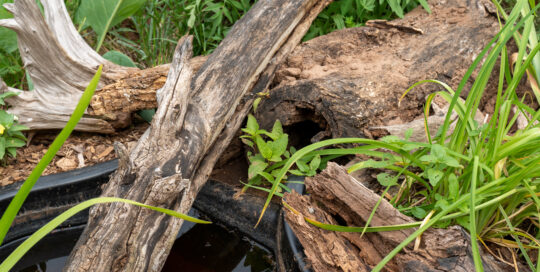Is rattlesnake master worth adding to your pollinator garden? Absolutely.
Views: 561

Rattlesnake master (Eryngium yuccifolium) is a native plant receiving more attention in gardening circles these days, particularly for pollinator gardens. I’ve had it growing in my yard for three years, and it is one of my favorite plants. Is rattlesnake master worth adding to your garden? Definitely.
Weirdly Delightful
Rattlesnake master looks like a thistle or a yucca, the latter being the source of its latin name, yuccifolium. However, it’s actually a member of the carrot family, more closely related to parsley than either thistles (Cirsium spp.) or yucca (Yucca spp.). Its close resemblance to yucca comes from its leaves, which have parallel veins rather than net-like veins, a rather unusual trait. Its flowers form densely-packed globes; each globe with around 100 flowers. Mature plants can have up to 40 globes, so that’s a lot of flower power!
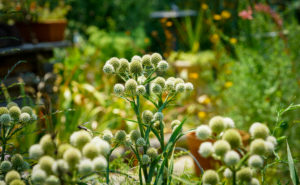
Rattlesnake master flower heads in the garden. With an average of 100 flowers per globe, you can see a huge number of flowers in this picture.
A pollinator paradise
With so many flowers per plant, rattlesnake master is a pollinator’s paradise. That’s reflected in the diversity of their many pollinators. On mine, I see many different wasps, soldier beetles, bees, butterflies, and pollinating flies. I have seen a gray hairstreak laying eggs on my rattlesnake master, and a rare moth, the Eryngium stem-borer moth (Papaipema eryngii), uses it as a host plant. Black swallowtails will also lay their eggs on rattlesnake master, although in my yard they tend to use bronze fennel. The featured picture on my previous blog showed a great golden digger wasp on rattlesnake master. This wasp is non-aggressive, preys on insect pests, and is incredibly beautiful when sunlight catches its blue wings and red body.
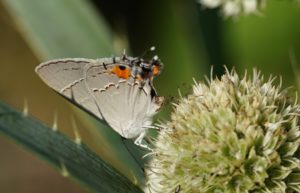
Gray hairstreak on rattlesnake master flower.
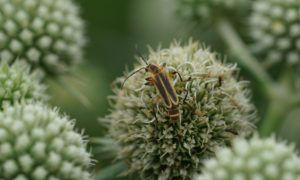
Margined leatherwing beetle.
Where should I plant it?
Rattlesnake master is native to most of the eastern United States. Its range extends from Florida to Ohio, north to Michigan, Wisconsin, and Minnesota, and west to Nebraska, Kansas, Oklahoma, and Texas. It prefers full sun and moist to medium dry soils, but, like most prairie natives, it has adapted to drought. Rattlesnake master has an extensive root system that allows it to survive hot, dry spells. Indeed, in my yard, it is one of the plants that doesn’t need much, if any, watering in July and August. Yet, I have it planted in areas where water collects during my wet and rainy springs.
I think rattlesnake master would do well in water gardens. It just needs several hours of sun.
This plant and its flower heads tend to be prickly, but it pairs surprisingly well with my other perennials. It can get quite tall, with the spikey flower stalks reaching 4-5 feet, and it tends to spread slowly by seed. I love the flower stalks sticking up above other plants, so I think it pairs well with mounding perennials. Its foliage has a silvery sheen to it so it also contrasts nicely with darker colors.
Rattlesnake master is a great plant for butterfly, native, and pollinator gardens. It will attract a variety of insects, and interesting predators like garden spiders, too.
Meet Leslie Miller
Leslie Ann Miller shares 3.5 acres in rural Oklahoma with birds, butterflies and wide variety of animals. She is currently transforming her yard with plantings…
Leslie's Recent Posts
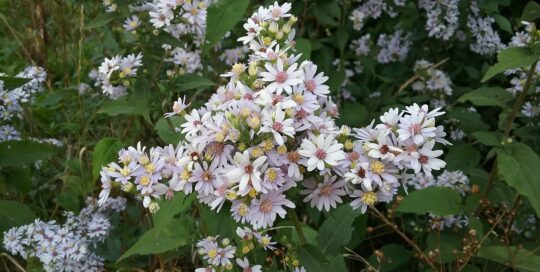
Drummond’s Aster: a native beauty that benefits bees
